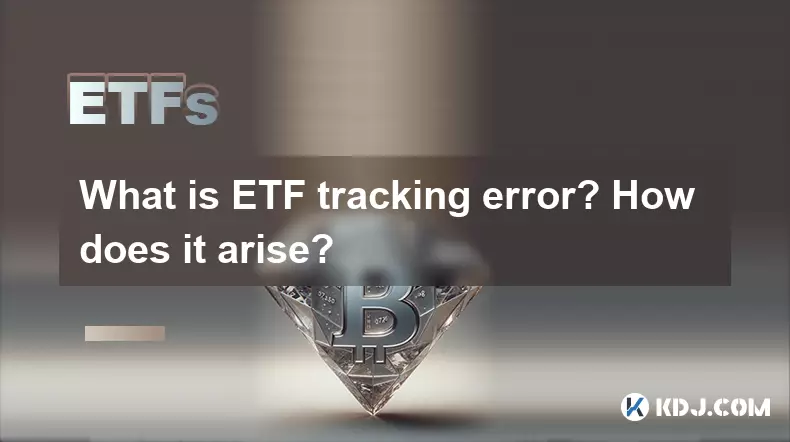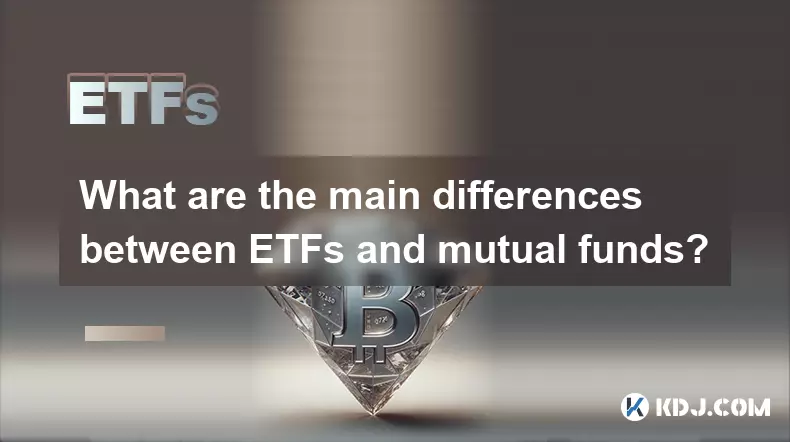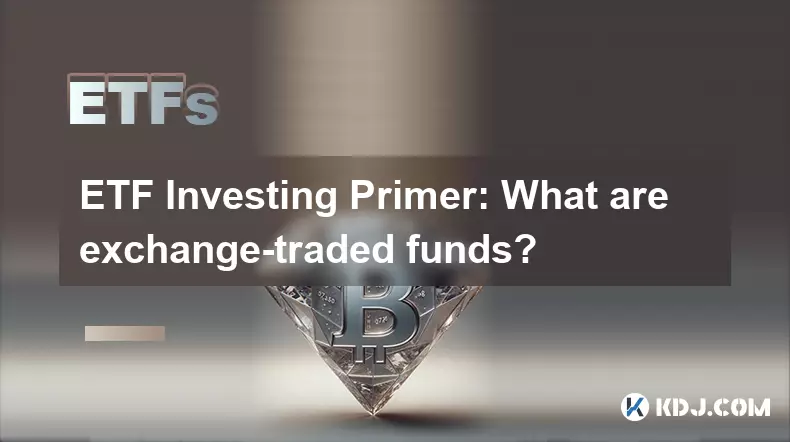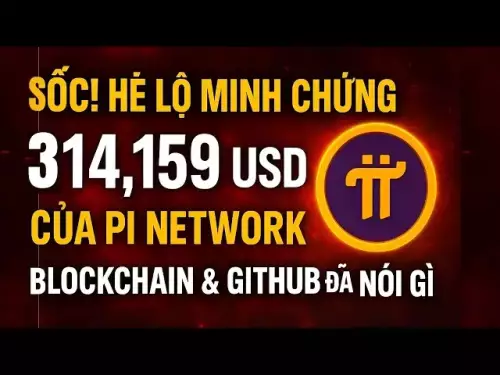-
 bitcoin
bitcoin $109547.008142 USD
0.04% -
 ethereum
ethereum $4011.838726 USD
-0.05% -
 tether
tether $1.000402 USD
-0.01% -
 xrp
xrp $2.798606 USD
0.88% -
 bnb
bnb $970.877944 USD
1.39% -
 solana
solana $202.237275 USD
-0.95% -
 usd-coin
usd-coin $0.999673 USD
0.00% -
 dogecoin
dogecoin $0.229294 USD
-1.15% -
 tron
tron $0.336370 USD
-0.45% -
 cardano
cardano $0.777260 USD
-1.66% -
 hyperliquid
hyperliquid $45.503019 USD
1.73% -
 ethena-usde
ethena-usde $1.000362 USD
0.01% -
 chainlink
chainlink $20.785303 USD
-1.10% -
 avalanche
avalanche $28.755822 USD
-0.11% -
 stellar
stellar $0.358303 USD
-0.48%
How do I understand the creation and redemption mechanisms of an ETF?
Crypto ETFs rely on authorized participants to maintain price stability through creation and redemption, ensuring market efficiency and investor confidence.
Sep 20, 2025 at 10:37 am

Understanding the Structure of ETFs in the Cryptocurrency Market
1. Exchange-traded funds (ETFs) have become a significant bridge between traditional finance and the digital asset space. In the context of cryptocurrency, an ETF allows investors to gain exposure to assets like Bitcoin or Ethereum without directly holding them. The creation and redemption processes are fundamental mechanisms that maintain the fund’s market price close to its net asset value (NAV). These processes involve authorized participants (APs), typically large financial institutions with direct access to the ETF issuer.
2. When demand for an ETF share increases, APs engage in the creation process. They assemble a basket of underlying assets—either physical crypto holdings or cash equivalent—based on the ETF’s prospectus requirements. This basket is delivered to the fund issuer in exchange for a block of new ETF shares, usually in increments of 50,000 units known as creation units. These newly created shares are then introduced into the secondary market, increasing supply and helping stabilize price discrepancies.
3. Redemption operates inversely. If there's excess supply of ETF shares trading below NAV, APs can purchase those shares on the open market and return them to the issuer. In return, they receive the underlying assets or cash value. This mechanism reduces the number of shares in circulation, supporting price equilibrium. Both creation and redemption occur off-exchange through private transactions between APs and issuers, minimizing market impact.
4. The arbitrage opportunities inherent in these processes incentivize APs to act swiftly when price deviations occur. For instance, if an ETF trades at a premium, APs profit by creating new shares and selling them at the higher market price. Conversely, if it trades at a discount, redeeming shares and liquidating the underlying assets yields a profit. This dynamic ensures tight alignment between the ETF’s market price and its intrinsic value.
5. In crypto-based ETFs, regulatory oversight adds complexity. Custody solutions must meet stringent standards, especially for physically backed products. Issuers often partner with regulated custodians to hold the actual digital assets securely. Transparency reports may disclose wallet addresses or proof-of-reserves, reinforcing investor confidence in the integrity of the underlying holdings.
The Role of Authorized Participants in Crypto ETFs
1. Authorized participants are pivotal in maintaining liquidity and pricing efficiency. These entities possess the infrastructure and capital required to execute large-scale transactions. Their ability to create and redeem shares directly with the ETF provider enables continuous adjustment of supply based on investor demand.
2. APs monitor real-time data feeds tracking both the ETF’s market price and the value of its underlying assets. Algorithms help detect mispricing, triggering automated responses to exploit arbitrage windows. Speed and precision are critical, as even minor delays can erode potential gains.
3. Due to the volatility characteristic of cryptocurrencies, APs face heightened risk during periods of rapid price swings. To mitigate exposure, they may hedge their positions using futures contracts or options on the same digital assets. Some also employ dynamic rebalancing strategies to manage portfolio risk while engaging in creation or redemption activities.
4. Not all market makers qualify as APs. Access is restricted and requires formal agreements with the ETF sponsor. This exclusivity ensures that only well-capitalized, compliant institutions participate in the primary market, reducing systemic risk and enhancing operational reliability.
5. The relationship between APs and ETF issuers is symbiotic. While APs earn profits from arbitrage, their actions benefit all shareholders by minimizing tracking error and ensuring smooth market functioning. Without this intermediary layer, ETF prices could deviate significantly from NAV, undermining trust and tradability.
Impact of Regulatory Frameworks on ETF Mechanics
1. Regulatory approval plays a decisive role in determining how a crypto ETF structures its creation and redemption process. For example, spot Bitcoin ETFs approved in certain jurisdictions require rigorous reporting on asset custody, whereas others may permit synthetic exposures through derivatives.
2. Compliance mandates influence the types of assets accepted during creation. Some regulators insist on direct ownership of the underlying cryptocurrency, verified through third-party audits. Others allow cash-in-lieu mechanisms, where APs deliver fiat money instead of digital assets, giving the issuer flexibility in acquiring holdings.
3. Jurisdictional differences affect redemption logistics. In regions with strict capital controls or limited crypto infrastructure, redemption might be settled in cash rather than the actual coin. This introduces counterparty risk but simplifies execution for local APs unfamiliar with blockchain operations.
4. Tax treatment varies across borders and impacts both APs and end investors. Gains realized during creation or redemption may trigger taxable events, influencing strategy design. Transparent tax reporting frameworks enhance predictability and encourage broader participation in the ETF ecosystem.
5. Regulatory clarity strengthens market integrity by defining permissible practices and enforcing accountability among all parties involved in ETF operations. As more countries establish guidelines for digital asset funds, standardization of creation and redemption protocols becomes increasingly feasible.
Frequently Asked Questions
What triggers the creation of new ETF shares?Creation is initiated when demand exceeds supply in the secondary market, causing the ETF’s price to rise above its net asset value. Authorized participants respond by assembling the required basket of assets and exchanging it with the issuer for new shares, which are then sold to meet investor demand.
Can individual investors participate in ETF creation or redemption?No, only authorized participants—typically large institutional firms—have the contractual rights and operational capacity to engage in primary market transactions. Retail investors buy and sell shares on exchanges like any other stock.
How does an ETF maintain parity between its market price and underlying value?Through arbitrage facilitated by authorized participants. When price diverges from NAV, APs execute creation or redemption to profit from the discrepancy, simultaneously correcting the imbalance and aligning the share price with its true value.
Are all crypto ETFs backed by actual digital assets?Not necessarily. While some ETFs hold physical cryptocurrency, others use futures contracts or other derivative instruments to replicate price performance. The structure depends on regulatory approvals and the fund’s investment objectives.
Disclaimer:info@kdj.com
The information provided is not trading advice. kdj.com does not assume any responsibility for any investments made based on the information provided in this article. Cryptocurrencies are highly volatile and it is highly recommended that you invest with caution after thorough research!
If you believe that the content used on this website infringes your copyright, please contact us immediately (info@kdj.com) and we will delete it promptly.
- XRP, Bitcoin Price Predictions: Decoding the Crypto Crossroads
- 2025-09-28 08:25:12
- ChatGPT, Crypto, and Crystal Balls: Predictions for a Wild 2025
- 2025-09-28 08:45:12
- Crypto Clash: Can Kaspa and Pi Coin Compete in a Remittix World?
- 2025-09-28 08:45:12
- Riding the Floki Wave: Gauging Gains with Social Engagement and Bottom Signals
- 2025-09-28 08:25:12
- Bitcoin's $109,000 Support: Will It Hold or Fold?
- 2025-09-28 09:05:14
- Crypto 2025: MoonBull Charges Ahead, Leaving Pepe and Mog in the Dust
- 2025-09-28 08:50:12
Related knowledge

How do I evaluate an ETF?
Sep 22,2025 at 11:18am
Evaluating the Fundamentals of an ETF1. Examine the underlying index the ETF tracks to understand its investment focus. Whether it follows a broad mar...

What is ETF tracking error? How does it arise?
Sep 20,2025 at 03:18am
Understanding ETF Tracking Error in the Cryptocurrency Market1. Exchange-traded funds (ETFs) have become a significant bridge between traditional fina...

What factors determine ETF liquidity?
Sep 26,2025 at 05:00pm
Understanding ETF Liquidity Drivers1. The underlying assets of an ETF play a crucial role in determining its liquidity. When the securities within the...

How do I understand the creation and redemption mechanisms of an ETF?
Sep 20,2025 at 10:37am
Understanding the Structure of ETFs in the Cryptocurrency Market1. Exchange-traded funds (ETFs) have become a significant bridge between traditional f...

What are the main differences between ETFs and mutual funds?
Sep 21,2025 at 06:01pm
Differences in Structure and Trading Mechanism1. Exchange-traded funds (ETFs) are traded on stock exchanges just like individual stocks, allowing inve...

ETF Investing Primer: What are exchange-traded funds?
Sep 21,2025 at 01:00pm
Understanding Exchange-Traded Funds in the Cryptocurrency Space1. Exchange-traded funds (ETFs) have become a bridge between traditional financial inst...

How do I evaluate an ETF?
Sep 22,2025 at 11:18am
Evaluating the Fundamentals of an ETF1. Examine the underlying index the ETF tracks to understand its investment focus. Whether it follows a broad mar...

What is ETF tracking error? How does it arise?
Sep 20,2025 at 03:18am
Understanding ETF Tracking Error in the Cryptocurrency Market1. Exchange-traded funds (ETFs) have become a significant bridge between traditional fina...

What factors determine ETF liquidity?
Sep 26,2025 at 05:00pm
Understanding ETF Liquidity Drivers1. The underlying assets of an ETF play a crucial role in determining its liquidity. When the securities within the...

How do I understand the creation and redemption mechanisms of an ETF?
Sep 20,2025 at 10:37am
Understanding the Structure of ETFs in the Cryptocurrency Market1. Exchange-traded funds (ETFs) have become a significant bridge between traditional f...

What are the main differences between ETFs and mutual funds?
Sep 21,2025 at 06:01pm
Differences in Structure and Trading Mechanism1. Exchange-traded funds (ETFs) are traded on stock exchanges just like individual stocks, allowing inve...

ETF Investing Primer: What are exchange-traded funds?
Sep 21,2025 at 01:00pm
Understanding Exchange-Traded Funds in the Cryptocurrency Space1. Exchange-traded funds (ETFs) have become a bridge between traditional financial inst...
See all articles










































































